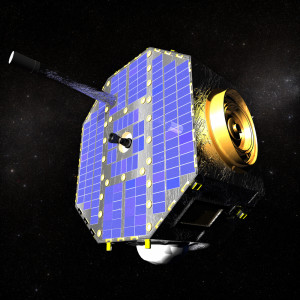 According to a press release from the Los Alamos National Laboratory, Space scientists and researchers presented the first detailed analyses of captured interstellar neutral atoms, at a press conference in Washington DC, sponsored by the National Aeronautics and Space Administration (NASA). The atoms represent the “essential raw material for the formation of new stars, planets and even human beings,” the statement read.
According to a press release from the Los Alamos National Laboratory, Space scientists and researchers presented the first detailed analyses of captured interstellar neutral atoms, at a press conference in Washington DC, sponsored by the National Aeronautics and Space Administration (NASA). The atoms represent the “essential raw material for the formation of new stars, planets and even human beings,” the statement read.
Data analyzed and presented at the conference was collected by the Interstellar Boundary Explorer (IBEX). Launched in October 2008, the IBEX has maintained an elliptical orbit around Earth using a pair of special cameras to sample neutral atoms reaching Earth’s surroundings from the edges of the solar system and its immediate neighborhood. The material captured by the spacecraft has traveled across the galaxy by solar and stellar winds.
Without the IBEX, obtaining samples like this would be extremely rare because our Earth is mostly shielded from direct bombardment by interstellar particles Sun in a way. The solar wind from our nearest star in effect creates a protective bubble around us that deflects charged particles back into space.
This protective layer, known as the heliosphere, prevents the Earth, and its occupants, from being bombarded by cosmic radiation. Operating in its elliptical orbit, the IBEX provides the first global view of the outer boundary of this protective bubble.
“Interstellar particles are the raw stuff that form stars, planets, and even us,” said Eberhard Moebius, a University of New Hampshire professor and IBEX team member currently on sabbatical at Los Alamos. UNH developed key systems of IBEX’s second camera. “In the beginning there was only hydrogen and helium. These two elements formed the first stars. When those stars collapsed and died, they spewed their material, including new elements created through the process of nuclear fusion, out into space. We can tell a lot about the evolution of our universe and perhaps gain insight into other galaxies and planetary systems by analyzing these particles.”
With the capacity to detect and analyze helium, hydrogen, neon, and oxygen, IBEX has been able to provide researchers with more information about our galactic neighborhood and raise some pressing questions about it. The IBEX research team has been able to characterize the ratio of oxygen to neon in Earth’s present location and compare it to other data. The IBEX observations suggest that the ratio of neon to oxygen in material emanating from outside our solar system is larger than the ratio from within our solar system and also the Milky Way—our home galaxy—as a whole.
The ratio difference may suggest that the Sun’s present location differs from its birthplace, or that a significant amount of oxygen might be bound up in grains of dust floating in interstellar space. Regardless of which hypothesis is correct, the IBEX mission findings are significant because this is the first time scientists have been able to gain direct quantitative measurements of the hydrogen, oxygen, and neon flow from outside our solar system, along with far more detailed observations of the interstellar helium flow.
The complete details of the research can be found in a special section in the February edition of Astrophysical Journal Supplements.
![Herbal Reference Substances are Key to Everyday Products <!-- AddThis Sharing Buttons above -->
<div class="addthis_toolbox addthis_default_style " addthis:url='http://newstaar.com/herbal-reference-substances-are-key-to-everyday-products/3512112/' >
<a class="addthis_button_facebook_like" fb:like:layout="button_count"></a>
<a class="addthis_button_tweet"></a>
<a class="addthis_button_pinterest_pinit"></a>
<a class="addthis_counter addthis_pill_style"></a>
</div>When it comes to quality control testing and the development of new products, Botanical Reference Materials (BRMs), also known as Herbal References are critically important. To help companies ultimately obtain all-important FDA approval, the Food and Drug Administration provides in its guidance a recommendation that […]<!-- AddThis Sharing Buttons below -->
<div class="addthis_toolbox addthis_default_style addthis_32x32_style" addthis:url='http://newstaar.com/herbal-reference-substances-are-key-to-everyday-products/3512112/' >
<a class="addthis_button_preferred_1"></a>
<a class="addthis_button_preferred_2"></a>
<a class="addthis_button_preferred_3"></a>
<a class="addthis_button_preferred_4"></a>
<a class="addthis_button_compact"></a>
<a class="addthis_counter addthis_bubble_style"></a>
</div>](http://newstaar.com/wp-content/uploads/2021/02/Achillea_millefolium_flowers-100x100.jpg)
![Quality Electrochemical Biosensors are Critical for Medical, Food and Chemical Industry <!-- AddThis Sharing Buttons above -->
<div class="addthis_toolbox addthis_default_style " addthis:url='http://newstaar.com/quality-electrochemical-biosensors-are-critical-for-medical-food-and-chemical-industry/3512086/' >
<a class="addthis_button_facebook_like" fb:like:layout="button_count"></a>
<a class="addthis_button_tweet"></a>
<a class="addthis_button_pinterest_pinit"></a>
<a class="addthis_counter addthis_pill_style"></a>
</div>A number of industries have, at their core, a need to frequent or even continuous analysis of biological media. These include the medical and pharmaceutical fields, biotech firms, and food and chemical companies. To maintain quality standards and develop new products, these industries rely heavily […]<!-- AddThis Sharing Buttons below -->
<div class="addthis_toolbox addthis_default_style addthis_32x32_style" addthis:url='http://newstaar.com/quality-electrochemical-biosensors-are-critical-for-medical-food-and-chemical-industry/3512086/' >
<a class="addthis_button_preferred_1"></a>
<a class="addthis_button_preferred_2"></a>
<a class="addthis_button_preferred_3"></a>
<a class="addthis_button_preferred_4"></a>
<a class="addthis_button_compact"></a>
<a class="addthis_counter addthis_bubble_style"></a>
</div>](http://newstaar.com/wp-content/uploads/2020/10/Electrochemical-Biosensor-100x100.jpg)
![Company Develops Industrial Mixers Well-Suited for both Fragile and Explosive Products <!-- AddThis Sharing Buttons above -->
<div class="addthis_toolbox addthis_default_style " addthis:url='http://newstaar.com/company-develops-industrial-mixers-well-suited-for-both-fragile-and-explosive-products/3512071/' >
<a class="addthis_button_facebook_like" fb:like:layout="button_count"></a>
<a class="addthis_button_tweet"></a>
<a class="addthis_button_pinterest_pinit"></a>
<a class="addthis_counter addthis_pill_style"></a>
</div>Industrial drum mixers are normally applied to blend mixes of varying viscosities such as adhesive slurries or cement. Some of these mixers have the capability of blending mixes of very different particle sizes such as fruit and ice cream, and gravel and cement slurry. The […]<!-- AddThis Sharing Buttons below -->
<div class="addthis_toolbox addthis_default_style addthis_32x32_style" addthis:url='http://newstaar.com/company-develops-industrial-mixers-well-suited-for-both-fragile-and-explosive-products/3512071/' >
<a class="addthis_button_preferred_1"></a>
<a class="addthis_button_preferred_2"></a>
<a class="addthis_button_preferred_3"></a>
<a class="addthis_button_preferred_4"></a>
<a class="addthis_button_compact"></a>
<a class="addthis_counter addthis_bubble_style"></a>
</div>](http://newstaar.com/wp-content/uploads/2020/06/bandeau-sofragir2-100x100.jpg)